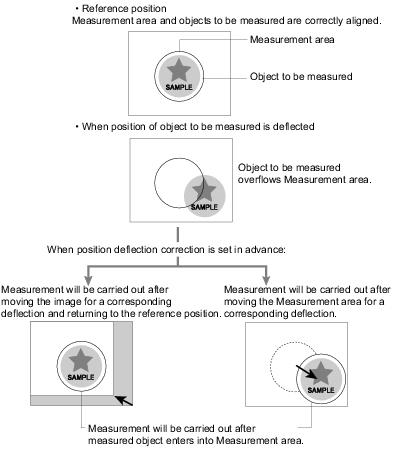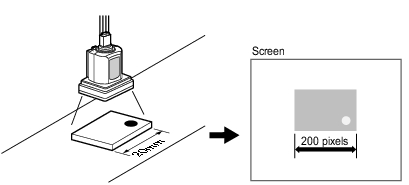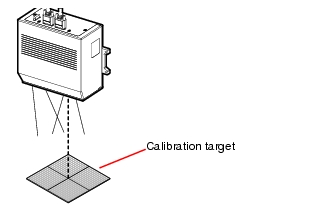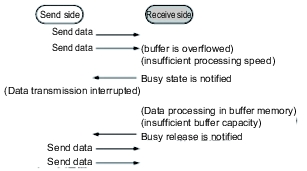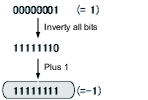Terminology
Position Compensation
Correct position deflection. When the location and direction of measurement objects are not fixed, the current location and displacement of reference shall be calculated and measured for compensation.
Please select Processing Items matching measurement objects from those Processing Items related to position compensation.
Intelligent Camera (with Lighting Function)
A camera with a dome-shaped light can also be controlled by controller. It is effective for cases such as when outside diffusion must be avoided or when lighting setting period must be shortened.
For details, see Intelligent Camera (with Lighting Function).
Intelligent Camera (with Lighting Function).
For details, see
Epipolar line
A point taken by a reference camera is projected to a straight line on an image taken by another camera. This straight line is called epipolar line.
Reference position
The point always treated as the reference. Default is the center of a model. If the location of the registered model is different from the basis, the setting should be changed in [Ref. position].
Calibration
By setting the relationship between Actual and camera Coordinate, the measurement results in pixel unit can be converted into actual size. To output the measured value converted by the calibration, set "Calibration" in "Output parameter" of each unit to "ON".
For example, an object that measures 20 mm wide and has a 200-pixel width in the measured image, the calibration is done as follows.
20 (mm) / 200 (pixel) = 0.1 (mm/pixel)
20 (mm) / 200 (pixel) = 0.1 (mm/pixel)
Measurement Flow
A series of measurement processes. You can combine Processing Items to create this measurement flow.
Detection point
The point to specify which part of the model the coordinates are to be output, as a processing item of search and ECM search. Default is the center of a model.
Candidate
In the "search" processing items, such as Search, Flexible Search, ECM Search, Classification, 3D Search, 3D Height, Character Inspection, and Model Dictionary, "Rough search" searches the entire area of the measurement region and "Detail search" searches only the regions whose correlations were high during the Rough search. "Rough search" is to search entire measured region, and "Detail search" is to search the region of which correlation was high in the "Rough search". Candidate is the point to be the candidate for "Detail search". Candidate LV represents the correlation value for "Rough search". If stable search of a model is not possible, set the Candidate LV lower.
3D Coordinates Registration
The setting when applying the 3D process to convert a measured value into an actual size by matching the coordinates of two cameras.
The setting is made with a special calibration tool.
The setting is made with a special calibration tool.
Scene
A combination of Units for measurement. A scene is created according to measurement objects or contents, used to switch measurement simply.
For details, see What is Scene.
What is Scene.
For details, see
Scene Group
32 Units are incorporated into a scene for sorted measurement. For details, see  What is Scene Group.
What is Scene Group.
Center of gravity
The images with white pixel are Cut into paper of a certain thickness, where a position is used to support the balance of paper. This position is called "Center of gravity". The gravity of circle object is the center of circle, the gravity of rectangle is the intersection of two diagonal lines.
Processing Item
A unit used for measurement. A scene (measurement flow) can be created after Processing Item is registered to Unit.
Processing Unit
A unit of measurement processing constituent. Processing items can be set for a processing unit to create a Scene (measurement flow).
For details, see What is Scene.
What is Scene.
For details, see
Correlation
0 to 100 are used to represent the degree of similarity of finished products, namely, a higher value indicates a higher degree of similarity.
Flow control
If the processing speed of receiving side is slower than that of sending side, the receiving side will send interruption commands to sending side, or send re-admittance commands and then adjust the transmission speed.
There are two flow control methods, including "Hardware Flow Control" and "Software Flow Control". In this product, "Software Flow Control" is used to adjust transmission speed.
Model
An image model for measurement object. Images with some features are extracted for Model Registration.
World coordinates
This is a coordinate system to locate a position of an object in a specified space. The system is used to display or handle the movement of objects. On the other hand, the coordinate system that is used when processing the shape or deformation of an individual object is called local coordinate system.
Unit
2's Complement
Binary number is generally used to represent a Minus.
"All digits of positive number are inversed bit wisely, and then added by 1" represent a Minus.
Example) "-1" is presented with 2's complement
"-1" can be calculated with "0-1"
"All digits of positive number are inversed bit wisely, and then added by 1" represent a Minus.
Example) "-1" is presented with 2's complement
"-1" can be calculated with "0-1"
Additionally, there are available with other simple computing methods.
Namely, "Minus = all digits of positive number inversed bit wisely plus 1".
Namely, "Minus = all digits of positive number inversed bit wisely plus 1".
